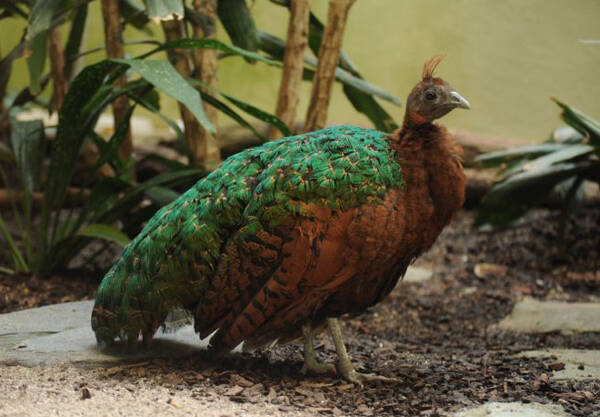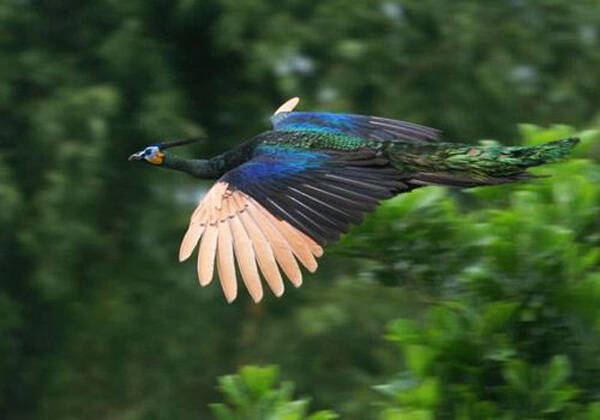Congo peafowl
IUCN
LCBasic Information
Scientific classification
- name:Congo peafowl
- Scientific Name:Congo peafowl,Congo Peacock,Afropavo congensis
- Outline:Landfowl
- Family:Chickeniformes P.family C.Peacock
Vital signs
- length:60-70cm
- Weight:1.2-1.5kg
- lifetime:No textual research information is available
Feature
Females are more beautiful than males
Distribution and Habitat
Congolese peacocks live only in central areas of the Democratic Republic of the Congo, where their distribution is extremely small and highly dispersed.
Congolese peacocks live in the depths of tropical rain forests below 1200 meters above sea level and are usually found near water sources.
Appearance
Congo peacocks are small, with males measuring 64-70 cm long and weighing about 1.5 kg. The female is 60-63 cm and weighs about 1.2 kg.
The male is decorated with fine colors, with a black undertone and a bronze-tinged sheen of dark green, with some darker feathers at the back, and purple-blue feathers on the chest and tail; With a bare neck of bright red skin, these vibrant males also have a bright, long, thick white mane crest, lacking the beautiful slender tail feathers of blue and green peacocks; But when the tail opens for display, there is an impressive fan side.
The female is slightly smaller than the male and has only a short raised crown, which is reddish-brown in color, with a metallic emerald plumage on the back, mixed with black markings, and a mostly dark brown underbody with a black belly.
Iris brown, mouth, legs, feet blue-gray. Contrary to the general rules of the bird world, the females appear to be more beautiful than the males, and their appearance is very d
Details
Congo Peacock (Afropavo congensis) : Congo peafowl, Congo Peacock, no subspecies. Congolese peacocks defy the general rules of the bird world, with females being more beautiful than males.

Congo peacock is an elusive mysterious bird, because living in Africa's dark, human and animal rare rainforest deep, coupled with a small number, so that people rarely have the opportunity to see it, until 1936 was the famous American zoologist Dr. James Chapin (Dr. James Chapin) officially named. The doctor had been tracking the exotic Okapi in Congo since 1913, and in 1934 saw the local mbulu people with reddish-brown feathers in their headdresses, and he had no idea what the bird was. Chapin visited the Royal Museum of Central Africa and saw two specimens of feathers called "Indian peacocks", which he found to be Congolese peacocks, a completely different species from Indian peacocks. In 1935, Chapin managed to find seven living specimens. The Congolese peacock has the physical characteristics of the peacock bird, indicating a connection between the Congolese peacock and the Asian peacock.
Congolese peacocks live in groups, each consisting of several families. Because its living environment has been relatively stable and closed for thousands of years, the breeding habits of the Congolese peacock have been degraded. This bird does not follow the polygamous marriage system of most birds, and one male only has one female for life. This habit is a problem in the captive breeding of its population. Unlike his promiscuous Asian relatives, male birds have been documented to peck other females to death after losing their spouses. Because of the loyalty to love, so the male bird used to attract the peacock characteristics. The beautiful tail feathers are reduced to short hairs.

Congolese peacocks have no fixed breeding season, and the timing of their breeding depends entirely on the arrival of the local rainy season. The male birds build nests with dead branches and leaves deep in the dense bush, and are responsible for guarding the female birds while they incubate their eggs. The female lays 3-4 eggs at a time, the eggs are beautiful cream brown, hatch for about 26-28 days, the young are raised by both parents after the shell, after 1-2 years of sexual maturity, life is unknown.
Guinee (Guinee) August 30, 2011 Issue: Afropavo congensis

Congolese peacocks are rare in number and have a low reproductive rate, so the survival prospects of this species are not optimistic. Due to the environmental damage caused by the perennial civil war in Congo and the influx of a large number of Rwandan refugees, the already endangered Congolese peacocks are decreasing day by day. The wild number of Congolese peacocks is only about 2,500, and the distribution area is only 700,000 square kilometers. There are only about 150 of them in captivity in zoos around the world.
Listed on the International Union for Conservation of Nature (IUCN) 2016 Red List of Threatened Species ver 3.1 - Vulnerable (VU).
Protect wild animals and eliminate wild meat.
Maintaining ecological balance is everyone's responsibility!








